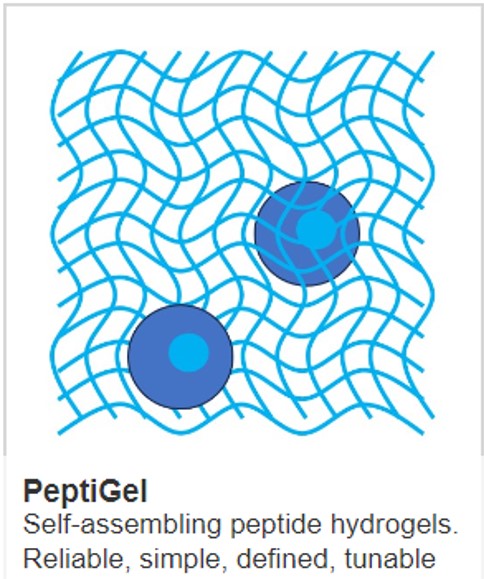Options for 3D Cell Culture: The Benefits of PeptiGel

3D cell culture has emerged as a pivotal technique for mimicking the natural environment of cells. This method offers a more physiologically relevant context compared to traditional 2D cultures, better enabling the study of cell behavior, drug responses, and disease mechanisms. In this article, we will delve into the pros and cons of various hydrogels used in 3D cell culture and highlight the unique benefits of using PeptiGel.
Natural Hydrogels
Pros:
Biocompatibility: Natural hydrogels, such as collagen, gelatin, and hyaluronic acid, are derived from biological sources, making them highly compatible with human cells.
Bioactivity: These hydrogels often contain cell-adhesive motifs and can be easily modified with growth factors that promote cell attachment, proliferation, and differentiation.
Cons:
Variability: Natural hydrogels can exhibit batch-to-batch variability, which may affect the reproducibility of experiments.
Limited Mechanical Strength: They often have weaker mechanical properties, which may not be suitable for all tissue engineering applications.
Synthetic Hydrogels
Pros:
Tunability: Synthetic hydrogels, such as poly(ethylene glycol) (PEG) and poly(vinyl alcohol) (PVA), offer precise control over their physical and chemical properties.
Reproducibility: These hydrogels have consistent properties and lower batch-to-batch variability compared to natural hydrogels.
Cons:
Bioinertness: Synthetic hydrogels are often bioinert and require modification with bioactive molecules to support cell adhesion and function.
Complexity in Functionalization: The process of incorporating bioactive signals into synthetic hydrogels can be complex and time-consuming.
PeptiGel: Synthetic and natural at the same time
PeptiGel stands out as a unique solution in the realm of hydrogels for 3D cell culture. It is a self-assembling peptide hydrogel that combines the advantages of both natural and synthetic hydrogels while mitigating their drawbacks.
PeptiGel Biocompatibility and Bioactivity
PeptiGel is designed to mimic the extracellular matrix (ECM), providing a highly biocompatible environment that supports cell growth, proliferation, and differentiation. Its composition allows for the incorporation of cell-adhesive sequences and growth factors, enhancing its bioactivity and making it conducive to various cell types, including sensitive primary cells and stem cells.
Tunable Mechanical Properties
One of the standout features of PeptiGel is its tunable mechanical properties. Researchers can easily select the stiffness and porosity of the hydrogel to match the physiological conditions of different tissues. This flexibility is crucial for studying specific cellular responses and for applications in tissue engineering where the mechanical environment plays a significant role in directing tissue formation.
Reproducibility and Ease of Use
PeptiGel offers the reproducibility and consistency often associated with synthetic hydrogels, ensuring reliable experimental outcomes. It is supplied as a ready-to-use formulation that simplifies the preparation process, significantly reducing the time and effort required to set up 3D cell cultures. This ease of use, combined with its reproducibility, makes PeptiGel an attractive option for both research and developing clinical applications.
Enhanced Cell Viability and Function
Studies have shown that cells cultured in PeptiGel exhibit enhanced viability and function compared to those grown in traditional hydrogels. The unique properties of PeptiGel allow cells to form more natural, tissue-like structures, which is critical for accurate disease modeling and drug screening applications. The ability of PeptiGel to support 3D cell culture in a manner that closely mimics the in vivo environment can lead to more predictive and relevant research outcomes.
Versatility
PeptiGel’s versatility extends to its compatibility with various cell types and its suitability for a wide range of applications, from basic research to regenerative medicine and drug discovery. It can be used in combination with other materials and technologies, such as 3D bioprinting, to create complex tissue constructs.
Conclusion
While each type of hydrogel has its pros and cons for 3D cell culture, PeptiGel emerges as a highly versatile and effective option that addresses many of the limitations associated with traditional materials. Its biocompatibility, tunable mechanical properties, ease of use, and enhanced support for cell viability and function make it a promising tool for advancing the field of tissue engineering and regenerative medicine. By closely mimicking the natural extracellular matrix, PeptiGel provides a conducive environment for studying complex biological processes, developing more accurate disease models, and screening potential therapeutic agents.
IMAGE Hydrogel CREDIT: Cell Guidance Systems
Learn more about powerful technologies that are enabling research:



